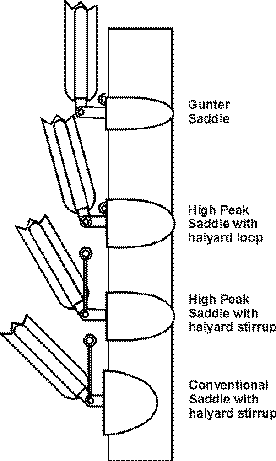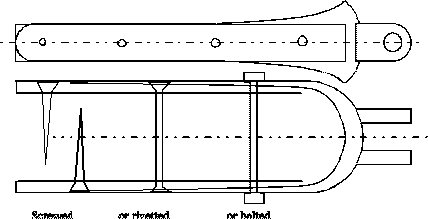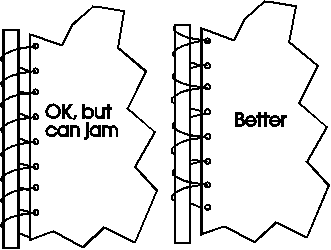Different ships, different saddles
In the good old days when gaffs lay at an angle of 45 to 50 degrees to the mast, the prime function of the gaff saddle or jaws was to accommodate the thrust of the gaff on the mast, and stop the thing falling off sideways. If you wanted to improve windward performance, you set a topsail. “Modern” gaffers tend toward the view that if you peak the gaff up higher and higher it goes better and you don’t have to muck around with topsails – the logical extension of which is Bermudan rig. It is not the place here to argue the pros and cons of high peaked gaff rig. But from the point of view of the fittings, as you peak the gaff up two things happen.
Firstly, the saddle/jaws now have to contend with not merely the thrust from the gaff, but also a twisting force which comes from the gaff being pressed to leeward by the sail. To get a feel for this imagine a gaff set at right angles to the mast. There could be no twisting moment – it would merely swivel around the mast – but there would be some force along the axis of the gaff into the mast. At the other extreme is a gunter yard, set parallel to the mast. There is no force along the gaff into the mast, by definition, but lots of sideways twisting. Why am I telling you all this? Because it explains why wooden jaws can be unsatisfactory on a high-peaked gaff since they are less able to cope with the twisting force on the gaff trying to prise the jaws apart. I last had a set of wooden gunter jaws break on me about a year ago for just this reason, on a boat submitted for review! It also explains why the traditional shape of gaff saddle – see figure 1 – tends to corkscrew its way off the mast if used for a high-peaked gaff. It is well shaped to cope with the thrust, but the “shoulders” are not shaped to cope with the twisting forces. It can therefore cause at least as many problems as it solves.
The second corollary of higher peak angles is that you very quickly run out of space to fit the throat halyard loop or stirrup, and so tend to have to move the halyard attachment to the upper part of the back face of the saddle itself. Now I know that this is not ideal – you should really have the sail and halyard connected at the same point – but I can’t think of another way round it.
All of which goes to explain – I hope – why we have ended up here with a family of gaff and gunter saddles based on three shapes of saddle, and two methods of attaching the throat halyard, the choice of which is primarily determined by the peak angle. The table summarises the choices shown in the picture .
| Gaff Saddle Types | ||
|---|---|---|
| Peak Angle | Saddle Type | Link Type |
| >40 degrees | Conventional | Stirrup & Loop |
| 30-40 degrees | High Peak | Stirrup & Loop |
| 15-30 degrees | High Peak | Loop |
| <15 degrees | Gunter | Loop |
The conventional saddle is of a traditional pattern and shape, since there is little point in changing what works. The “High Peak” variant is shallower, but with its “shoulders” extended further around the mast to resist twisting, and depending on the peak angle it can be fitted with a conventional halyard attachment or a loop on the back face of the saddle. The “Gunter” saddle is shallower (and stronger) still and is almost always fitted with a loop on the saddle for the throat halyard, unless the yard itself is attached to the halyard.
Details
With regard to the construction of the saddle itself, there are two things to aim for. Firstly, a saddle should be as light as possible to reduce topweight. Generally speaking, that implies a fabricated rather than a cast saddle, and it also favours one or other type of steel as opposed to say bronze. For a given weight steel is stiffer, and usually stronger, depending on the alloy. The other aspect is to have reasonably widely spaced lugs joining the gaff itself to the saddle. Again this becomes more important the higher the peak, since there are more unfair loads on the connection the higher you peak the gaff. I think I’ve had to fix two saddles which used the old style single lug on the back of the saddle. Leather is still generally favourite for covering the saddle – it looks well and works well. For a more modern interpretation of the theme, I have heard of enterprising Cornishmen who cut a sheet of plastic from a bucket and massage it into place with a heat gun and impact adhesive!
What about the gaff itself?
So much for the saddle, what about the gaff? Well, the gaff end fitting doesn’t need a great deal of explanation, the usual scheme being a strap type of thing with two lugs to fit the saddle. As for fixing it, bolts are effective but protrude – at least at the nut end, and copper rivets look well (and also work fine for galvanised end fittings despite the theoretical risk of galvanic action). But for those of you, like me, whose chances of drilling a hole clean through a gaff to match the holes in the fitting are so close to zero as makes no odds, offset screws are probably the safest option. The picture shows the options.
Moving up the gaff, all that stuff about avoiding bending and keeping pure compression in the spars really counts for nothing here, because – with the possible exception of sprit rigs – I can’t think of an example of a loose-headed sail. Head lacing means that the gaff is always being loaded laterally. The task then is to minimise the bending which results from this, and the way to achieve that is to distribute the load from or into the peak halyards along the gaff using spans. I was going to try and be clever and advise you how to place these for maximum effect, but a quick review of any book with pictures of gaff rigged boats will show that the arrangements adopted – which all work – are so varied as to defy analysis. In theory, too, the peak halyard should be pulling at right angles to the gaff. In practice this is almost never the case, if only because the mast is rarely tall enough to allow such an arrangement. All of which boils down to the fact that I can only tell you two moderately interesting things about gaff halyards. Firstly, the purchases on the peak and the throat halyards should be the same. This is so you can easily hoist the gaff horizontally – on a smaller boat by holding both halyards together, on a larger one by two people hoisting at the same rate. The idea is that you hoist horizontally until the throat is tight, and then peak the gaff up. The second thing is that the halyards will foul mast hoops if they are taken to cleats on the mast or turning blocks mounted close in to the mast. Apart from fitting pinrails, one way round this is to use lacing instead of hoops. This leads me more or less seamlessly into a brief digression on mast hoops and lacing.
Hoops and string
The traditional British way to attach the luff of the mainsail to the mast is to use wooden mast hoops, usually made from steamed ash, or sometimes oak. These are shaped on the inside face to prevent binding on the mast, and comprise about 2½ turns of wood – sort of key-ring fashion. They are nearly impossible to fit once the mast is dressed with rigging etc, so the prudent person fits a spare one or two whenever the opportunity occurs. And that you may think is that. Well there are two principal variations on the theme. The first option is to use metal – usually galvanised steel – hoops covered with leather or served with marline. These have significant advantages over wooden hoops in that they don’t break so readily, if ever, and that they can be re-galvanised and re-covered at suitable intervals. It is also possible to make them in such a way that they can be fitted onto a rigged mast. The disadvantage that they are heavier, and therefore tend to droop and so jam, can be minimised by incorporating a small vertical piece where the sail lashing goes, such that when tension is applied to the luff of the sail by the halyard, then the hoop is held horizontal.
The other variant is to use mast lacing – and millions of Dutchmen can’t all be wrong. Lacing has the advantages of costing as many pennies as hoops do pounds, reducing weight and windage aloft, being fittable at any stage, and lying close to the mast so not fouling halyards which go to mast cleats or turning blocks at the base of the mast. The two most commonly quoted disadvantages are that lacing jams more readily, a situation improved if the lacing runs in a round-and-back fashion rather than spirally – see picture – and that mast hoops provide a ready made ladder for you to climb the mast whereas lacing does not. Indeed.
I think I’m with the Dutch on this issue. Next stop – booms.



